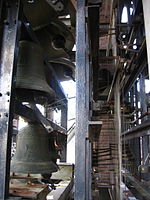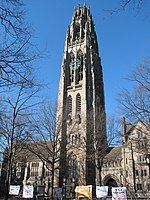Battell Chapel

Battell Chapel is the largest chapel of Yale University in New Haven, Connecticut. Built in 1874–76, it was funded primarily with gifts from Joseph Battell and others of his family. Succeeding two previous chapel buildings on Yale's Old Campus, it provided space for daily chapel services, which were mandatory for Yale College students until 1926 (all-male, mostly Protestant). Together with Durfee Hall and Farnam Hall, the chapel was part of a program begun in the 1870s to build up the perimeter of Old Campus and separate it from the rest of the city. These three buildings, all by the same architect, were among the first at Yale to be named for donors rather than function, location, or legislative funding. Battell Chapel is one of the locations on the Connecticut Freedom Trail.
Excerpt from the Wikipedia article Battell Chapel (License: CC BY-SA 3.0, Authors, Images).Battell Chapel
New Haven
Geographical coordinates (GPS) Address Nearby Places Show on map
Geographical coordinates (GPS)
| Latitude | Longitude |
|---|---|
| N 41.309 ° | E -72.928 ° |
Address
New Haven
Connecticut, United States
Open on Google Maps








